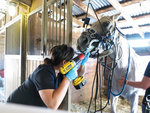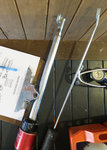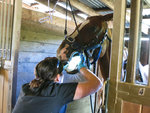


“Don’t look a gift horse in the mouth.” An aging person is “long in the tooth.” The well-known idioms date to an earlier time but their origins are as true today. The sayings stem from the fact that you can learn a lot about a horse by simply looking in its mouth.
Equine dental care has become a specialty. Veterinarians have a growing understanding of the horse’s oral health, and horses now commonly live into their 20s and 30s, so their teeth need to last longer, too. And, a horse’s dental health affects not just their teeth but also their overall health.
During a dental visit, the veterinarian will evaluate the teeth, jaw and inside of the mouth, and adjust the grinding surface of the teeth using specially designed tools. The dental visit is a valuable chance to take an overall look at the horse’s health, said Dr. Anne Ray of Ridgefield Equine Clinic in Ridgefield. The exam will check the horse’s temperature, pulse and respiration, and evaluate their body condition.
The horse’s upper jaw is slightly wider than the lower, which enables them to grind coarse grasses but also causes sharp points to develop along the edge of the teeth. These points and uneven wear cause difficulty chewing, change the alignment of his bite, and score the cheek tissue, causing abrasions and potentially ulcers.
And, horses can develop a range of infections and dental diseases. Weight loss, behavioral problems and training difficulties can all be associated with dental disorders.
Like humans, horses develop two sets of teeth during a lifetime. The deciduous teeth, or baby teeth, erupt during the first six months of life, and begin to be replaced by adult teeth at around age two and a half. Early abnormalities can contribute to excessive dental wear over time, and detection in the first year can prevent problems down the road, said Dr. Ray.
Some horses have “wolf teeth,” a small, vestigial tooth which erupts just in front of the premolars. Wolf teeth were useful to prehistoric horses, but the tooth is no longer needed and can cause pain when a horse begins to wear a bit. Wolf teeth are usually removed, and it is far easier to remove wolf teeth during the first year, said Dr. Ray, before the teeth are set firmly into the bony jaw.
When the horse begins to shed its deciduous teeth around age two, a “cap” or baby tooth can sometimes be retained and cause discomfort and difficulty chewing. It may even cause the permanent tooth to erupt in a crooked position. The equine dentist can remove such a retained cap during treatment.
And while deciduous teeth are softer than adult teeth, they can still develop sharp points.
“We typically see abrasions (to the inner cheek) during the first visit,” said Dr. Ray, a result of the sharp tooth edges.
By age five, most horses have their full set of permanent teeth. A horse’s teeth erupt continually throughout their lifetime and are worn down by the grinding of forage. This ongoing growth means the teeth need regular inspection for abnormal wear and the development of sharp points.
Horses can also experience a full range of dental disorders, including infected, broken or even missing teeth. Because the teeth erupt continuously, removing a tooth means the opposing tooth will require ongoing maintenance or removal to prevent problems with chewing.
X-rays can be used to identify infected or broken teeth, but the treatments are less simple. Endodontic work, such as a root canal, is difficult in horses because their teeth are so long, said Dr. Ray. Extraction is difficult for the same reason.
Having a gap between two teeth can allow food to become packed into the space, and lead to problems with the gums and teeth roots.
And, as the horse ages “cupping” can occur, said Dr. Ray. In this case the center of the tooth surface becomes smoother and provides less grinding to chew forage. This is most often seen in horses reaching their late teen years or 20s.
Though many dental concerns aren’t so different for horses than for humans, the procedure looks a little different than a trip to your local human dentist.
The process of filing sharp points off the teeth is called “floating,” and most equine dentists will use power tools for the procedure. The equipment bears familiar names like DeWalt and Makita, but it doesn’t come straight from the carpenter’s toolbox; the tools are modified to accept specially made metal files on the end of long steel shanks. The oscillation of the tool effectively files sharp edges and uneven wear from the horse’s teeth.
The horse is typically sedated for the procedure, and an oral speculum engages the upper and lower arcade of teeth to hold the mouth open for treatment. A dental halter with a padded chin rest helps to support the groggy horse’s head by suspending it from an overhead support.
After sharp points and hooks have been filed from the teeth with power tools, a final shaping with a hand float finishes the job.
Other health problems can come to light during the dental examination. If a horse is underweight, it is usually due to one of three causes, said Dr. Ray: teeth problems, poor nutrition or internal parasites. A dental exam can help to identify the underlying cause of the horse’s poor condition.
Most horses require dental care annually. It can form the basis of a routine horse care plan and a chance to review any health changes with your veterinarian. Plus, a veterinarian will be able to respond to any complications that might occur during the procedure.
Many people expect to see particular symptoms, such as weight loss, dropping grain or resistance to the bit, to indicate a dental problem, said Dr. Ray, but that isn’t always the case.